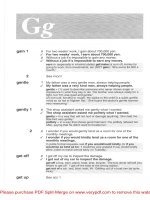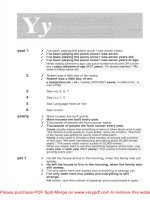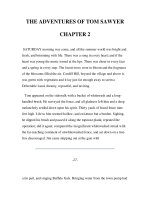Single channel and whole cell electrophysiological characterizations of l type cav1 2 calcium channel splice variants relevance to cardiac and nervous system functions
Bạn đang xem bản rút gọn của tài liệu. Xem và tải ngay bản đầy đủ của tài liệu tại đây (4.44 MB, 139 trang )
SINGLE-CHANNEL AND WHOLE-CELL
ELECTROPHYSIOLOGICAL CHARACTERIZATIONS OF
L-TYPE Ca
V
1.2 CALCIUM CHANNEL SPLICE VARIANTS:
RELEVANCE TO CARDIAC AND NERVOUS SYSTEM
FUNCTIONS
PETER BARTELS
NATIONAL UNIVERSITY OF SINGAPORE
2013
SINGLE-CHANNEL AND WHOLE-CELL
ELECTROPHYSIOLOGICAL CHARACTERIZATIONS OF
L-TYPE Ca
V
1.2 CALCIUM CHANNEL SPLICE VARIANTS:
RELEVANCE TO CARDIAC AND NERVOUS SYSTEM
FUNCTIONS
PETER BARTELS
-Diploma Biologist-
University of Cologne, Germany
A THESIS SUBMITTED FOR THE DEGREE OF
DOCTOR OF PHILOSOPHY
DEPARTMENT OF PHYSIOLOGY
YONG LOO LIN SCHOOL OF MEDICINE
NATIONAL UNIVERSITY OF SINGAPORE
2013
i
Declaration
“I hereby declare that this thesis is my original work and it has been written by me in its
entirety. I have duly acknowledged all the sources of information which have been used
in the thesis.
This thesis has also not been submitted for any degree in any university previously.”
Peter Bartels
4
th
of January, 2013
ii
"Ja, Kalzium, das ist alles"
Otto Loewi (1873-1961), German Pharmacologist
ACKNOWLEDGEMENTS
iii
Acknowledgements
Facing the PhD was a thrilling challenge with many ups and downs. It would not have
been possible without the help and support of so many people in so many ways…I am
deeply thankful…
First and foremost, I would like to thank my supervisor Tuck Wah Soong for his
patience, guidance, and never ending support he gave me. It sparked my passion and
hunger for future endeavors in the exciting field of calcium channel research.
I thank my TAC members Sanjay Khanna and Chian Ming Low who were always
supportive and ready to answer my questions. Thank you for all the suggestions
throughout the project.
I am also very thankful to the many current and former members of the Soong lab.
Especially, I would like to thank Mui Cheng, Yuk Peng, Tan Fong and Chye Yun who
gave me useful insights into the field of molecular biology and Dejie Yu for her great
support of fresh cells and electrophysiology. Dr Liao Ping for his construct, Dr Li Guang
and Dr Juejin Wang for insights into their research area and help in biochemistry. Alex,
Zhai Jing, Qingshu and Huang Hua for general support. Markus Rouis Quek Weng Sung,
whom I supervised throughout his bachelor project and who delivered valuable data.
Finally Dr. Nupur Nag and Hendry Cahaya for much laughter beside the bench.
ACKNOWLEDGEMENTS
iv
I express gratitude to my collaborators in Austria, Nicolas Singewald and Simone Sartori
(University of Innsbruck) for offering precious animal samples and Stefan Herzig and
Uta Hoppe from Germany (University of Cologne) for the support of human samples.
Finally, I am most grateful to my beloved mother in Germany. Without your support I
would not have reached my goal. Rosi my beloved wife. She gave me support and
strength throughout the hard days.
TABLE OF CONTENT
v
Table of Content
TABLE OF CONTENT V
LIST OF PUBLICATIONS I
ABSTRACT: II
LIST OF TABLES V
LIST OF FIGURES VI
ABBREVIATIONS VIII
1. INTRODUCTION 1
1.1 ROLE OF VOLTAGE-GATED CALCIUM CHANNELS VGCCS IN HUMAN PHYSIOLOGY 2
1.2 THE L-TYPE FAMILY OF VOLTAGE-GATED CALCIUM CHANNELS. 5
1.2.1. Physiological implication of calcium channel Ca
V
1.2
in the cardiovascular system 7
1.2.2 Cardiovascular diseases (CVDs) in global society 10
1.2.3 Mental disorders in modern global society. 11
1.2.4 Neurobiology of fear and anxiety 12
1.2.5 Physiological implication of VGCCs in mood disorders. 13
1.3 TRAIT ANXIETY MOUSE MODEL HAB/LAB/NAB.
IMPLICATIONS OF CA
V
1.2 IN MENTAL DISEASE 14
1.4 MOLECULAR ASPECTS OF CA
V
1.2 L-TYPE CHANNELS IN HUMAN PHYSIOLOGY 16
1.4.1 Alternative splicing 16
TABLE OF CONTENT
vi
1.4.2 Alternative splicing of L-type Ca
V
1.2 calcium channel isoforms. 18
1.4.2.1 Functional role in biology and disease 18
1.4.2.2. N-terminal hum Ca
V
1.2 isoforms and implication on structure and
function relationship 20
1.4.2.3. Exons 21/22, 31/32 and cassette exon 33 and its contribution to
physiology and disease 21
1.5. SINGLE-CHANNEL VS. WHOLE CELL RECORDINGS IN CARDIOVASCULAR STUDIES 24
1.6 AIMS AND GOALS OF THE STUDY 26
2. MATERIAL AND METHOD 28
2.1 CELL CULTURE AND PLASMIDS 29
2.1.1 Culture of native HEK293 cells 29
2.1.2 Plasmids and generation of constructs 29
2.1.3 Sub-cloning of humCa
V
1.2 variant 778a into a cardiac backbone structure 31
2.1.4 Transient transfection of HEK 293 cells 32
2.1.4.1 Calcium phosphate method 32
2.1.4.2 The Effectene
®
method 32
2.3. MOLECULAR BIOLOGY 33
2.3.1 mRNA extractions from HAB, LAB and NAB
mouse brains for colony screening. 33
TABLE OF CONTENT
vii
2.3.2 Reverse Transcription and transcript-scanning
by Polymerase Chain Reaction. 34
2.3.3 Transcript scanning of mutually exclusive exons 8/8a, 21/22 and 31/32
and cloning into a pGEM®-T Easy vector 36
2.4. ELECTROPHYSIOLOGY 38
2.4.1 The Patch-Clamp Technique 38
2.4.1.2 The cell-attached configuration: detecting single ion channels 41
2.4.2 The Single-Channel Setup 43
2.4.3 Experimental design and theoretical background 43
2.4.4 Data analysis and statistics 47
2.4.5 Writing event lists 48
2.4.6 Determine the unitary current amplitude 49
2.4.7 Correction of multiple channels (k ≥ 1) 50
2.5 STATISTICS 54
3. RESULTS 55
3.1 EXON 33 DELETION OF MURINE CA
V
1.2 INCREASES THE CURRENT DENSITY BY
INCREASING SINGLE-CHANNEL OPEN PROBABILITY 56
3.1.1 Single-channel fast kinetic parameters of Ca
V
1.2 33
-/-
are significantly
altered compared to Ca
V
1.2
(+/+)
61
TABLE OF CONTENT
viii
3.1.2 Single-channel activation of Ca
V
1.2 33
-/-
is significantly reduced by 3 times
compared to Ca
V
1.2
+/+
64
3.2 FUNCTIONAL ROLE OF THE N-TERMINUS OF HUM CA
V
1.2 IN A RECOMBINANT
SYSTEM (HEK 293) UNDER WHOLE-CELL CONDITIONS. 66
3.2.1 Exon 1a/1b of humCa
V
1.2 regulates channel inactivation in a
voltage-dependent manner. 66
3.2.2 Exon 1b/1a of humCa
V
1.2 influences the current density [pA/pF]. 68
3.2.2.1 The N-terminal exon 1b increases the current-density of humCa
V
1.2 (IV) 70
3.2.2.2 The N-terminal exon 1b increases the current-density of humCa
V
1.2 (GV) 71
3.3 STRUCTURE AND FUNCTIONAL ANALYSIS OF THE N-TERMINUS OF
HUMCA
V
1.2 UNDER SINGLE-CHANNEL CONDITIONS. 72
3.3.1 The N-terminus of hum Ca
V
1.2 isoforms does not alter single-channel
gating properties. 72
3.3.2 Exon 1b of humCa
V
1.2 decelerates and exon 1a accelerates time-dependent
inactivation in single-channel experiments (I
150ms
). 73
3.3.3 Exon 1b of humCa
V
1.2 increases channel surface expression in HEK 293 cells
(A gating current analysis) 78
3.4. SPLICING PROFILE AND DISTRIBUTION OF MURINE CA
V
1.2 MUTUALLY EXCLUSIVE
EXONS OF HAB/LAB AND NAB MICE DID NOT REVEAL ANY DIFFERENCES IN BRAIN
AREAS ASSOCIATED WITH FEAR/ANXIETY. 82
TABLE OF CONTENT
ix
3.4.1 Generation of exon specific transcripts of mutually exclusive hotspot regions
of the murine alpha1C subunit (Cav1.2). 82
3.4.2 Exon patterns of mutually exclusive regions in Ca
V
1.2 of HAB/LAB/NAB
mice do not reveal any significant difference among animals with trait anxiety. 83
3.4.3 Combinatorial splicing of HAB/NAB and LAB animals 85
4. DISCUSSION 88
4.1 FINAL DISCUSSION 88
4.2 EXON 33 OF MOUSE CA
V
1.2PLAYS AN IMPORTANT ROLE IN CHANNEL
FUNCTION WITH SEVERE PATHOPHYSIOLOGICAL CONSEQUENCES. 88
4.2.1 Limitations of this study. 93
4.3 THE N-TERMINUS OF CA
V
1.2 REGULATES CHANNEL INACTIVATION
AND SURFACE EXPRESSION 93
4.4 PHYSIOLOGICAL/PATHOPHYSIOLOGICAL RELEVANCE AND LIMITATIONS 98
4.5 THE N-TERMINUS OF CA
V
1.2 DOES NOT ALTER BASIC SINGLE-CHANNEL
GATING PROPERTIES. 100
4.6 ALTERNATIVE SPLICING OF CA
V
1.2 IN ANIMALS WITH TRAIT ANXIETY DOES
NOT REVEAL ANY POTENTIAL PATHOPHYSIOLOGICAL SPLICING FINGERPRINTS. 101
4.7. GENERAL CONCLUSION AND FUTURE PROSPECTS 104
5. REFERENCES 106
LIST OF PUBLICATIONS
I
List of Publications
Diploma thesis:
Peter Bartels, Kerstin Behnke, Guido Michels, Ferdi Gröner, Toni Schneider, Margit
Henry, Paula Q. Barrett,Ho-Won Kang, Jung-Ha Lee, Martin H.J. Wiesen, Jan Matthes,
Stefan Herzig.”Structural and biophysical determinants of single Ca
V
3.1 and Ca
V
3.2 T-
type calcium channel inhibition by N
2
O”, Cell calcium 46(2009) 293-302.
PhD thesis:
Guang Li, Ping Liao, Juejin Wang, Peter Bartels, Hengyu Zhang, Dejie Yu, Mui Cheng
Liang, Kian Keong Poh, Chye Yun Yu, Fengli Jiang, Tan Fong Yong, Guangqin Zhang,
Mary Joyce Galupo, Jin Song Bian, Sathivel Ponniah, Scott Lee Trasti, Uta C. Hoppe,
Stefan Herzig and Tuck Wah Soong. “Cardiac Electrical Remodeling via Alternative
Splicing of Ca
V
1.2 Channels produces Ventricular Arrhythmia”. (Manuscript in
preparation)
Bartels Peter, Liao Ping, Soong Tuck Wah.” N-terminal regulation and surface
expression of alternatively spliced human Ca
V
1.2”. (Manuscript in preparation)
ABSTRACT
II
Abstract:
The L-type Ca
V
1.2 calcium channel forms a hetero-oligomeric complex which is
comprised of a transmembrane pore-forming
1
-subunit, associated and modulated
by auxiliary - and
2
-subunits. Ca
V
1.2 channels are abundantly expressed in the
cardiovascular and nervous systems where their activation initiates a rapid influx of
Ca
2+
ions through their membrane spanning pores, triggering various cell responses
such as excitation-contraction coupling in the heart muscle, gene expression and
synaptic plasticity in the CNS. Alternative splicing of Ca
V
1.2 has been associated
with changes in the electrophysiological and pharmacological properties of the
channel (Liao et al., 2007; Liao et al., 2004; Tang et al., 2004) and is furthermore
implicated in severe cardiovascular and neuronal dysfunctions (Splawski et al.,
2004; Tiwari et al., 2006). This PhD thesis focuses on how the significance of
alternative splicing in generating channel functional diversity could be evaluated by
using an in vitro expression system as well as a more complex ex vivo system. We
show that the exclusion of the single cassette exon 33 of Ca
V
1.2 in a mouse genetic
mutant, deleted specifically of alternative exon 33, results in Torsade de pointes, a
severe form of arrhythmia well documented in cardiovascular disease of humans.
Specific exon exclusion, which results in altered channel gating property, triggers
arrhythmia in our animals and is due to a 4 times higher single-channel open
probability of Ca
V
1.2
∆33
compared to the wild type channel. This emphasizes that
ABSTRACT
III
single alternative exon exclusion in Ca
V
1.2 can result in severe electrophysiological
changes coupled to cardiac electrical remodeling leading to ventricular arrhythmia
of the heart.
In a related question, the electrophysiological and expression characteristics of the
mutually exclusive N-terminal exons 1a/b of Ca
V
1.2 was evaluated. This pair of
mutually exclusive exons in combinations with another pair of mutually exclusive
exons 8/8a define the smooth muscle SM isoform of exon 1b/8 and the cardiac
muscle CM isoform of 1a/8a (Abernethy and Soldatov, 2002; Biel et al., 1990; Liao
et al., 2004; Tang et al., 2004; Zuhlke et al., 1998). Preliminary data support the
hypothesis that the SM 1b isoform compared with the cardiac muscle CM isoform
1a showed higher level of membrane surface expression. Data obtained from whole-
cell recordings clearly indicated for a 2-fold increase in current density for the SM
channels, which could be determined by a tail current analysis. A gating current
analysis obtained from tail currents did support the notion that the higher current
density was due to higher channel surface expression. Furthermore, we could
demonstrate that exon 1b in combination with exon 8a changes the channel kinetic
by shifting the steady-state inactivation to a more hyperpolarized potential. Similar
findings indicating for the possible role of exon 1b in channel inactivation could be
obtained from single-channel recordings. However, the basic single-channel
properties did not reveal any differences in channel gating supporting our findings
that an elevated current density is more likely due to a higher SM Ca
V
1.2 channel
surface expression than to a higher channel gating probability.
ABSTRACT
IV
In a collaborating work with the group of Nicolas Singewald, Austria, we wanted to
address the question of whether alternative splicing of Ca
V
1.2 is a major contributor
in fear response in HAB, LAB, NAB animals. In this context dissected brain areas
associated with the fear circuitry were analyzed with the transcript-scanning
method (Soong et al., 2002) to determine the transcript levels for various mutually
exclusive exons of Ca
V
1.2 in the amygdala, hippocampus and prefrontal cortex. We
detected no overt changes in splicing patterns that would predict any
electrophysiological changes in Ca
V
1.2 brain regions associated with fundamental
emotional and social traits. Interestingly, from its physiological function the brain
channel isoform Ca
V
1.2 seems to be more of a cardiac version in regards to the high
expression of exons 8a/22/32.
Taken together, this PhD thesis provided additional conceptual support in regards
to the physiological and pathophysiological implications and consequences that
underlie alternative splicing in Ca
V
1.2 calcium channel isoforms. The work further
demonstrates that electrophysiological characterization at the single-channel level is
a powerful tool to help further dissect the mechanisms to account for alterations in
whole-cell channel properties in alternative splice variants of the Ca
V
1.2 channels in
both ex-vivo and in-vitro systems.
LIST OF TABLES
V
List of tables
Table 1: Primer pairs used for PCR 34
Table 2: Synopsis of channel properties of murine Ca
V
1.2 (+/+)
and Ca
V
1.2 ∆33 (-/-) 65
Table 3: Electrophysiological WC properties of Ca
V
1.2 isoforms 80
Table 4: Single-channel properties of Ca
V
1.2 isoforms. 81
LIST OF FIGURES
VI
List of figures
Figure 1: Overview of the Ca
V
calcium channel family 3
Figure 2: Schematic overview of the
1C
channel pore with auxiliary α
2
δ,
β and subunits 5
Figure 3: Excitation-contraction coupling. 8
Figure 4:Diagram showing the performance on HAB, NAB and LAB animals
on the elevated plus maze EPM 14
Figure 5: Schematic overview of alternative splicing as a fundamental molecular
process of PTM. 17
Figure 6: Hypothetical topology of the Ca
V
1.2 splice variants. 19
Figure 7: Amino acid sequence representing the long form (1a) 46 aa
and short form (1b) 16 aa of human CACNA1C 20
Figure 8: Steady-state kinetics of ∆33 of Ca
V
1.2 in cardiomyocytes. 23
Figure 9: N-terminal splice variants with backbone structure cloned into the
MCS of a pcDNA3.1 vector 30
Figure 10: Identification of representative CACNA1C bands on a 1% gel. 31
Figure 11: Overview of several patch clamp configurations. 38
Figure 12: Over simplified diagram of a patch-clamp setup. 43
Figure 13: Indirect current registration of a patch clamp setup. 46
Figure 14: Overview how to analyze single-channel data. 47
Figure 15: Illustration of a leak subtracted current trace with the activity of one
Calcium channel (T-type). 48
Figure 16: Representative isolated cardiomyocyte used for patch-clamp
experiments. 56
Figure 17: 20 consecutive exemplary traces of murine ventricular Ca
V
1.2
wild type (+/+) and Ca
V
1.2 33
-/-
ablated knock-out (-/-). 57
Figure 18: Altered channel open probability NP
open
(k<2) of cardiomyocytes
upon depolarization over several TP. 58
Figure 19: Exemplary time course representing the open probability of Ca
V
1.2
wild type (+/+) (black) and the Ca
V
1.2 33-/-(red). 59
Figure 20: Exemplary mean ensemble average currents from Ca
V
1.2
wild type (+/+) and Ca
V
1.2 33
-/-
at different test potentials. 60
Figure 21: Statistics for Single-channel experiments. 61
LIST OF FIGURES
VII
Figure 22: Open- and closed-time statistics describing arithmetic mean values. 62
Figure 23: Representative dwell-time open histograms. 63
Figure 24: Representative dwell-time close histograms. 64
Figure 25: Representative first latency distribution quantifying the channel
activation time. 65
Figure 26: Steady-state activation obtained from tail currents. 67
Figure 27: Steady-state inactivation SSI by stepping and prepulses. 69
Figure 28: IV relationship of Ca
V
1.2 SM and CM isoforms. 70
Figure 29: Current density obtained from tail currents. 71
Figure 30: Consecutive exemplary single-channel traces. 74
Figure 31: Representative exemplary dwell time histograms. 75
Figure 32: Exemplary time-course distribution of Ca
V
1.2 isoforms. 76
Figure 33: Channel inactivation estimated from mean-ensemble average currents. 77
Figure 34: Gating current analysis. 79
Figure 35: Transcript scanning of alpha1C from prefrontal cortex (PFC),
hippocampus (HIP) and amygdala (AM) 82
Figure 36: Exemplary gel photos showing specific exon profiles of mutually
exclusive hot spot regions in alpha1C from different brain areas. 84
Figure 37: A total of 16 different splice combinations were identified with the
transcript-scanning method. 86
Figure 38: Hypothetical model of calcium channel inactivation 96
Figure 39: Idealized steady-state activation/inactivation kinetics 99
ABBREVIATIONS
VIII
Abbreviations
AD/DA Analog to digital converter
ATP
+
Adenosine triphosphate
fA Femto Ampere
nA Nano Ampere
pA Pico Ampere
ANOVA Analysis of Varianz
AV Atrioventricular
BaCl
2
Barium chloride
bp Base pair
BLAST Basic Local Alignment Search Tool
BNC banana network cable
°C Degree Celsius
CaCl
2
Calcium chloride
CACNA1 Genes of the calcium channel α-subunitsα1A-H and α1S
CD1 Cluster of differentiation 1
CICR Calcium Induced Calcium Release
CO
2
Carbone dioxide
CPU Central processing unit
CREB cAMP-responsive element binding
CsOH Caesium hydroxide
CVDs Cardiovascular Diseases
DHP Dihydropyridines
DMEM Dulbecco's Modified Eagle Medium
DNA Deoxyribonucleic acid
DTT Dithiotreitol
e.g. Exempli gratia; for example
EGTA Ethylene glycol tetraacetic acid
EPM Elevated plus maze
ERK Extracellular signal-regulated kinase
fig. Figure
GFP Green fluorescent protein
h Hour
HAB High- anxiety behavior
HEK Human Embryonic Kidney
HEPES (4-(2-hydroxyethyl)-1-piperazineethanesolfonic acid
HBS Hepes buffered saline
HIV Human immunodeficiency virus
HP Holding potential
HVA High-voltage activated
Hz Hertz
KHz Kilo Hertz
ABBREVIATIONS
IX
KCl Potassium chloride
KOH Potassium hydroxide
KO Knock out
L Liter
LAB Low-anxiety behavior
LB Luria-broth medium
LVA Low-voltage activated
k Kilo
kb Kilo base pairs; 10
3
base pairs
MAP Mitogen activated protein
M Molar
mM Milimolar
ms Millisecond
MeSO
3
Methylsulfate
MgCl
2
Magnesium chloride
min. Minute
mRNA Messenger Ribonucleic acid
mV Millivolt
µl Micro liter; 10
-3
liter
ng Nano gram; 10
-9
gram
OA Open arm
P
CMV
Promoter (cytomegalovirus)
PD Parkinson’s disease
PTM Posttranscriptional modification
MAPK Mitogen-activated protein kinase
MCS Multiple cloning site
N Number or amount
NAB Normal-anxiety behavior
NCBI National Center for Biotechnology Information
NCX Na/Ca exchanger
NIH National Institute of Health
PBS Phosphate Buffered Saline
PCR Polymerase chain reaction
pH Potentia hydrogenii
PKC Protein kinase C
PP2B Phosphatase 2 B
PTSD Post-traumatic stress disorders
RMS Root mean square
RNA Ribonucleic acid
rpm Revolutions per minute
RYRs Ryanodine Receptors
ABBREVIATIONS
X
RT Room temperature
SA Sinoatrial Node
SERCA Sarco-Endoplasmatic Reticulum Calcium ATPase pump
shRNA Short hairpin Ribunucleic acid
SNP Single Nucleotide Polymorphism
SR Sarcoplasmic Reticulum
SSRI Serotonin selective reuptake inhibitor
TEA Tetraethyl ammonium
TP Testing Potential
U Uracil or Voltage
UTR Untranslated Region
UV Ultra Violet
V Volt
VGCCs Voltage-gated calcium channels
VSMC Vascular smooth muscle cells
WT Wild type
w/v Weight per Volume
1
Chapter I
1. INTRODUCTION
Chapter I
1. INTRODUCTION
2
1.1 Role of voltage-gated calcium channels VGCCs in human physiology
The examination of the physiological role of voltage-gated Ca
2+
channels VGCCs has
been the research focus of scientists for a long time. The families of Ca
2+
channels are
expressed in various cell types where they open upon sensing membrane depolarization
to allow an influx of divalent Ca
2+
ions into the cell. The influx of Ca
2+
ions is carefully
controlled by fine-tuned mechanisms as these divalent ions cannot be metabolized and
therefore need to be sequestered within intracellular organelles or shunted out of the cell
into the external matrix. However, the cytoplasmic increase in Ca
2+
ions triggers a
number of physiological responses including: (1) muscle contraction via activation of
Ca
2+
dependent/sensitive Ryanodine receptors RyRs by releasing Ca
2+
ions out of the
Sarcoplasmic Reticulum (SR) into the cytoplasm (Bers, 2002; Reuter, 1979); (2)
transduction of Ca
2+
signals via complex signaling pathways (CREB/MAPK), regulating
gene expression in the cell (Dolmetsch et al., 2001; Greenberg et al., 2008);(3) releasing
of neurotransmitters from the pre-synaptic terminals and modulation of neuronal
plasticity in the brain(Catterall and Few, 2008; Moosmang et al., 2005). Furthermore,
various clinically relevant drugs against VGCCs or against their auxilliary subunits have
been reported to reduce neuropathic pain (Fossat et al., 2010; Olivera et al., 1994)or even
having an influence on severe major depression and bipolar disorder (Mallinger et al.,
2008; Pazzaglia et al., 1998).
Chapter I
1. INTRODUCTION
3
Figure 1: Overview of the Ca
V
calcium channel family. The pedigree showing the
sequence identity of the 10 genes encoding for HVA high- and LVA low voltage-
activated calcium channels. Adopted and modified from Catterall et al., 2003.
The physiological and pharmacological properties of recorded nativeCa
2+
currents had led
to the assumption of the presence of various types of VGCCs (Reuter, 1979).
Bean and Nilius could demonstrate in1985for the presence of two different Ca
2+
currents
in cardiomyocytes with high and low threshold activation characteristics, and with fast
and slow channel inactivation components. The Ca
2+
current activation profiles in
smooth, cardiac and skeletal muscle were very similar and predominantly detectable at
higher voltage steps whereas inactivation was long lasting when Ba
2+
was used as a
charge carrier (Tsien et al., 1988). Additionally, these currents could be blocked by Ca
2+
channel antagonists such as dihydropyridines, phenylalkylamines and benzothiazepines
(Reuter 1979; Tsien et al., 1988). This led to the categorization of the high-voltage
activated (HVA), long-lasting (L-type) calcium channels and their low-voltage activated
counterparts showing a faster and transient (T-type) inactivation kinetic (Nowycky et al.,
1985) and being insensitive to conventional Ca
2+
channel antagonists. The L-type
channels were further known to be regulated by second messenger proteins, auxiliary
subunits and Ca
2+
binding proteins. In 1975 Hagiwara could show the different types of
Chapter I
1. INTRODUCTION
4
L-type calcium channels in starfish eggs which was then further characterized by
Carbone and Lux in voltage-clamped dorsal root ganglion cells (Carbone and Lux, 1984).
Nowycky and colleagues could later demonstrate from dissociated DRG and single-
channel experiments about the presence of the N-type calcium currents which were
activated at voltage ranges in between the potentials that activate L-and T-type currents.
Additionally, this channels could be blocked selectively by the peptide ω-conotoxin
GVIA from the marine cone snail Conus geographus (Tsien et al., 1988; Olivera et al.,
1994). Characterizations of other Ca
2+
channel subtypes followed like the P/Q- and R-
types being identified by pharmacological blockade using various other spider toxins
(Llinás and Yarom, 1981; Llinás et al., 1989). Whereas, L- and T-types can be found in
nearly all cell types, the latter subtypes can be found predominantly in the central nervous
system CNS.









